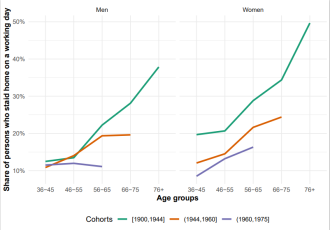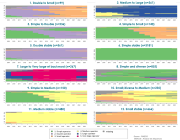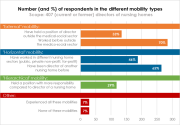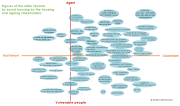

Julie PELATA analyses the day-to-day mobility of older adults across age groups and generations. To get a broader picture, she takes into account immobility, as it may reveal difficulties in getting out of the house, which could hamper social participation in public space.
Her work is based on the decennial French National Transport Surveys (NTS), which are run on a representative sample of people living in private households. They are asked to report each trip they have made on public space on a given day. The proportion of people who did not leave home, the immobility rate, is estimated by age groups within different cohorts, using the four survey editions (from 1981-82 to 2018-19). To do so, age and year of birth are crossed in a pseudo-panel approach.
Julie PELATA shows that the proportion of immobile people on an average weekday increases with age, regardless of generation. This would be expected as functional limitations increase with age.
However, she found a sharp decline in immobility across generations after the age of 55. Before this age, the decline was only seen in women, as immobility was already low among young men. This trend reflects the gendered pace of changes in activities and practices. For example, driving was democratised for women later than for men. Although women have significantly increased their activities and mobility in recent decades, they are still more immobile than men after the age of 55, even in the 1960-75 cohorts. These differences raise issues of sedentary lifestyles and social isolation.
She concludes that in-home care policies need to extend the scope of their actions outside people's houses. In addition of care and services, these policies need to provide residential environments that prevent a locked-in future, for people to take their place in society.
* Source et champ : French National Travel Surveys 1981-1982, 1993-1994, 2007-2008, 2018-2019 - Insee, SDES (producers), Progedo-Adisp, SDES (diffusion) - Scope: individuals living in private (not collective) housing (mainland France) - Interpretation: for the 46-55 age group, the immobility rate for the most recent cohorts (1960-1975) is 12% for men and 13% for women. This is the rate of people who stayed at home (or in their garden) on the day designated by the survey. These figures are estimated from the answers of people who were born between 1960 and 1962 in the 2007-2008 survey and those who were born between 1963 and 1973 in the 2018-2019 survey.
Doctorante en sociologie, Université Gustave Eiffel. DEST - Dynamiques économiques et sociales des transports
- Pélata, J., Armoogum, J., Gabaude, C., & Garcia, C. (in press). Factors explaining frequent immobility in France. Transportation Research Procedia. 16th World Conference on Transport Research, Montréal, Canada.
- Pélata, J., Boussion, B., Armoogum, J., & Garcia, C. (2023, June). Voyager après la retraite. 5èmes Rencontres Francophones Transport Mobilité. https://hal.science/hal-04192687
- Pélata, J., Meissonnier, J., Armoogum, J., & Gabaude, C. (2023, July). La voiture comme caddie? Dialogue entre recherches qualitatives et quantitatives. Intersections, Circulations - 10e Congrès de l’AFS. https://hal.science/hal-04190366








